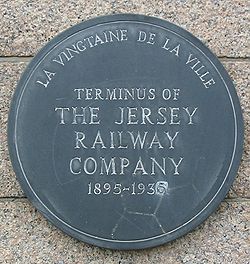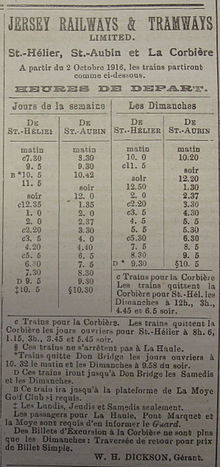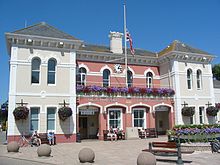- Jersey Railway
-
Coordinates: 49°11′10″N 2°06′25″W / 49.186°N 2.107°W
Jersey Railway / Jersey Railways & Tramways 
Plaque on old St Helier terminusLocale Jersey Dates of operation 1870–1936 Track gauge standard gauge till 1884 then 3 ft 6 in (1,067 mm). Length 73⁄4 miles (12.5 km) Headquarters Saint Helier The Jersey Railway was opened in 1870 and was originally a standard gauge railway, 3.75 miles (6.0 km) long, in Jersey in the Channel Islands. Converted to narrow gauge in 1884 and extended, the line closed in 1936. It is not to be confused with the Jersey Eastern Railway.
Contents
History
In 1864 the States of Jersey passed a law authorising the construction of the island's first railway. This standard gauge line was constructed, connecting St. Helier to St. Aubin, and the first train ran 25 October 1870. This railway was not a success and the company declared bankruptcy in 1874. The railway continued to operate but passed through a succession of proprietors until 1883.
Meanwhile the owner of a granite quarry near La Moye had petitioned to build a railway linking his quarry to St. Aubin. This law passed in June 1871 and the St Aubin & La Moye Railway commenced construction to the narrow gauge of 3 ft 6 in (1,067 mm). This line too, ran into financial problems and although construction trains ran on the section from La Moye to Pont Marquet, the company declared bankruptcy in 1878 before completion or opening to the public.
In 1883 the Jersey Railway and the partially completed St Aubin & La Moye Railway were amalgamated into the Jersey Railways Company Limited. The St. Helier to St. Aubin line was relaid to 3 ft 6 in (1,067 mm) gauge and the railway re-opened to passengers on 15 March 1884, initially operating as two separate sections until the two lines were connected at St. Aubin in 1885 to form a complete railway. The first through service ran between St Helier and La Corbière on 5 August 1885.
This railway too hit financial difficulties and in 1895 entered voluntary liquidation.
In 1896 a new company, the Jersey Railways and Tramways Co. Ltd. was formed to take over the assets of the failed company. The railway was improved, with an extension to La Corbière Pavilion opening in 1899 and was successful up to the outbreak of the First World War. The railway continued during the war, but by 1917 traffic had declined significantly. In 1922 the decision was made to introduce railcars to reduce operating costs. These helped the company to revive its fortunes in the mid 1920s with 1925 being the peak in terms of passengers carried and profitability. The Jersey Railway was not a typical sleepy narrow gauge railway, instead operating a very intensive commuter style timetable peaking at 32 trains in each direction in 1925, when almost 1.1 million passengers were carried.
By 1928 competition from buses and private cars were threatening the railway's future.
The decline was quite rapid and by 1932 the winter service had been withdrawn. In October 1936 a fire destroyed the roof of St. Aubin station and consumed 16 carriages. The line did not reopen for the 1937 summer season, and all remaining locomotives and railcars were scrapped in 1937.
The States of Jersey purchased the route of the line from St Helier to La Corbière on 1 April 1937 for the sum of £25,000. The rails were lifted and the smaller stations demolished.
The route
The Jersey railway, in its final form, was a single track route with passing places at the termini, Millbrook, St Aubin and Don Bridge.
The main station at the Weighbridge (now Liberation Square) in St Helier was the operating headquarters of the line and featured an impressive building, glass roof and two platforms.
The locomotive sheds and maintenance workshops were also at this location. The workshops were capable of very heavy repair work and the manufacture of carriages - the distance from the mainland made the railway very self-sufficient.
Between St Helier and St Aubin, the railway ran a picturesque route along the seafront - between the beach and main promenade road (Victoria Avenue).
Millbrook station featured two platforms and a footbridge. It was moved and rebuilt on a new site in 1912 to make way for an extension to the seafront promenade.
St Aubin station, the original limit of operations, had two platforms and another impressive glass roof. When the line was extended to La Moye in 1884, an additional platform was added, bypassing the original terminus that continued in use for the St Helier - St Aubin trains.
After St Aubin, the railway turned sharply inland through a rock-lined tunnel and climbed steeply away from the sea, rising over 200 ft in 1.5 miles with gradients as steep as 1 in 30. The summit was reached just after Don Bridge Station. The track then dropped towards La Corbière where the substantial granite-built station overlooked the lighthouse. La Corbière station had a loop line but only one passenger platform.
German Occupation
On 1 July 1940, German forces occupied Jersey, Hitler declaring that the Channel Islands would become an impregnable fortress.
Work was soon begun building gun emplacements, bunkers, tunnels and sea walls.
To support this work, the occupying German army (Organisation Todt) re-opened almost the entire St. Helier to La Corbière line to 1,000 mm (3 ft 3 3⁄8 in) gauge. This line was used for construction materials and never carried passengers. A branch line was built to serve the large granite quarries at Ronez in the north of the island. This joined the La Corbière line at Pont Marquet. At the St Helier end of the line, the original Weighbridge terminal was bypassed and the rails went direct to the dockside quays and linked with the 60 cm gauge lines in the east of the island (following the route of the old Jersey Eastern Railway which had closed in 1929).
Steam and diesel locomotives worked the line for the duration of the war but it seems to have fallen out of use by 1945 and the line was taken up at the cessation of hostilities by the liberating troops.
Remains
It is possible to walk or cycle over the entire route of the Jersey Railway as a seafront promenade, cycle track and walking and cycling trail now occupy the trackbed.
In St Helier, the 1901 headquarters and terminus building at the Weighbridge housed Jersey Tourism until 2007, although the fine ironwork of the station canopy has long gone. The site behind the former terminus building is now Liberation Station, the main bus terminus.[1]
The intermediate station at Millbrook (built 1912) is now the Old Station Cafe and the station building and hotel at St Aubin now serves as the Parish Hall of Saint Brelade. Beyond St Aubin, the tunnel built in 1899 to avoid some tight curves is still there, although much enlarged as a wartime munitions store.[2] Walkers can enjoy the trackbed and its bridges, embankments and cuttings right to La Corbière. The Old Station House at La Corbière, registered as a Building of Local Interest, was sold by the States of Jersey to the private sector in 2004.[3] Planning permission was granted to convert the house into a modern architectural showpiece.
Although there is no chance now of travelling the route by train, the locomotive nameplates are on display in the National Railway Museum in York and locomotive No.5 'La Moye' is preserved intact in South Africa where she worked in industry until 1992. Many photographs and artefacts can also be found at the Pallot Steam Museum in Jersey and in a display in the Jersey Museum in St Helier.
Standard Gauge Locomotives
Name Builder Type . Date Built Works number Notes Haro Haro Sharp Stewart 2-4-0T 1870 2047 Withdrawn in September 1884 when gauge changed. Used during construction of the Manchester Ship Canal (opened May 1894). Sold to the Woolpit Brick & Tile Co, Suffolk (photo). Duke
of NormandySharp Stewart 2-4-0T 1870 2048 Withdrawn in September 1884 when gauge changed. Used during construction of the Manchester Ship Canal (opened May 1894). Sold to T. W. Ward of Sheffield and re-sold in 1897 to the Vulcan Foundry, Newton-le-Willows as a yard shunter. Scrapped 1904. (Photo of 'Haro Haro' and 'Duke Of Normandy' at St Helier c1870 [1])
Sharp Stewart 2-4-0T 1871 2140 Larger design than Haro Haro and Duke of Normandy. Re-shipped to Tunis Railway, Tunisia in May 1872. North Western Sharp Stewart 2-4-0T 1872 2241 Identical replacement for #2140 above. Sold to Jersey Eastern Railway in May 1878. Re-sold for use in a Scottish Quarry and left Jersey in 1898. General Don Dubs 2-4-0T 1879 1222 Withdrawn in September 1884 when gauge changed. Sold to North Cornwall Railway then to Weston, Clevedon and Portishead Railway in 1901. Renamed Clevedon in 1906. Scrapped in 1940. (photo [2]) Narrow Gauge Locomotives and Railcars
Number Name Builder Type Date Built Works number Notes General Don Black Hawthorne 0-4-2ST 1877 Supplied to and used in construction of the St Aubin & La Moye railway. Left Jersey by 1900
Black Hawthorne 0-4-2ST 1877 Supplied to and used in construction of the St Aubin & La Moye railway. Left Jersey by 1900
1 St. Heliers Manning Wardle 2-4-0T 1884 916 Rebuilt with larger boiler in 1910. Scrapped in Jersey. Nameplates preserved at National Railway Museum, York. (Photo at St Aubin Station [3])
2 St. Aubins Manning Wardle 2-4-0T 1884 917 Rebuilt with larger boiler in 1909. Scrapped in Jersey. Nameplates preserved at National Railway Museum, York.
3 Corbiere W.G. Bagnall 2-4-0T 1893 1418 Rebuilt with larger boiler in 1907. Scrapped in Jersey. Nameplates preserved at National Railway Museum, York.
4 St. Brelades W.G. Bagnall 2-4-0T 1896 1466 Rebuilt with larger boiler in 1912. Offered to York museum for preservation in 1937. Accepted but not delivered. Scrapped in Jersey. Nameplates preserved at National Railway Museum, York. (Photo at St Helier Weighbridge Station [4])
5 La Moye Andrew Barclay 2-4-0T 1907 1105 Little used after 1918. Sold in 1928 to the Victoria Falls Power Company in South Africa, later passing to ESCOM. Withdrawn from service in 1992. Now preserved in South Africa by SANRASM (South African National Railway And Steam Museum), near Johannesburg. (Photo at St Helier Weighbridge Station [5]) (Photo of loco preserved in South Africa [6])
Railcar 1 Pioneer No. 1 Sentinel Steam railcar 1923 4863 The first railcar built by Sentinel-Cammel. Scrapped / Sold in 1935
Railcar 2 Pioneer No. 2 later Portelet
Sentinel Steam Railcar 1924 5159 A more powerful version of Pioneer No. 1 (Photo at St Aubin Station [7]) Railcar 3 La Moye Also known as the Wembley Car
Sentinel Steam Railcar 1925 5833 Exhibited at the 1925 Wembley Exhibition. Railcar 4 Normandy Sentinel Steam Railcar 1925 5655 Purchased from the standard gauge Jersey Eastern Railway in 1930 via A.O. Hill Ltd. and converted to 3 ft 6 in (1,067 mm) gauge. W.J. Carmen states: After closure Normandy was used - with passenger accommodation removed to become a flat bed - to remove the track as it was lifted) See also
References
- The Jersey Railway, N.R.P.Bonsor (Oakwood Press) ISBN 0-85361-344-3
- Thomas, Cliff (2002). The Narrow Gauge in Britain & Ireland. Atlantic Publishers. ISBN 1-902827-05-8.
- A Chronology of Jersey, Ralph Mollet, Jersey 1954
* "Channel Island Transport Fleet Histories. Vol. 2 Bailiwick of Jersey", W.J. Carman, 1995 (no ISBN)
External links
- Photo [8]
- Photo of St Aubin Station [9]
- Photo of Locomotive No.3 at the Corbiere Platform of St Aubin station c1906 [10]
Parishes
(Vingtaines)Saint Helier (de la Ville · du Rouge Bouillon · de Bas du Mont au Prêtre · de Haut du Mont au Prêtre · du Mont à l'Abbé · du Mont Cochon)
Trinity (de la Ville-à-l'Évêque · de Rozel · du Rondin · des Augrès · de la Croiserie)
Grouville (des Marais · de la Rue · de Longueville · de la Rocque · Les Minquiers)
Saint Brélade (de Noirmont · du Coin · des Quennevais · de la Moye)
Saint Clement (Grande Vingtaine · du Rocquier · de Samarès)
Saint John (du Nord · de Hérupe · du Douet)
Saint Lawrence (de la Vallée · du Coin Hâtain · du Coin Motier · du Coin Tourgis Nord · du Coin Tourgis Sud)
Saint Martin (de Rozel · de Faldouet · de la Quéruée · de l'Église · du Fief de la Reine · Les Écréhous)
Saint Mary (du Sud · du Nord)
Saint Ouen (Petite Cueillette · Grande Cueillette · Cueillette de Grantez · Cueillette de Millais · Cueillette de Vinchelez · Cueillette de Léoville)
Saint Peter (du Douet · de St. Nicolas · Grand Vingtaine · des Augerez · du Coin Varin)
Saint Saviour (de Maufant · de Sous la Hougue · des Pigneaux · de la Grande Longueville · de la Petite Longueville · de Sous l'Église)History and
Historic SitesLa Cotte de St Brelade · Dolmens (La Hougue Bie) · Mont Orgueil · Grosnez Castle · Elizabeth Castle · Battle of Jersey · La Corbière Lighthouse · Windmills · Jersey Railway · Jersey Eastern Railway · German Occupation during World War II · War Tunnels · (Jersey Heritage · National Trust)
Government,
Law and JusticeDuke of Normandy · Lieutenant Governor · Bailiff (List) · States Assembly · Council of Ministers · Chief Minister · Elections · (Parties: Jersey Democratic Alliance · Centre Party · Jersey Conservative Party) · Parish Assembly · Procureur du Bien Public · Courts · Jurats · Judiciary · Viscount · Greffier · States of Jersey Police · Honorary Police · Customs and Immigration · Royal Militia
Symbols Economy Jersey pound (Coins) · the former Jersey livreCulture Religion · Jersey Legal French · Jèrriais language · Jèrriais literature · Music · Opera House · Battle of Flowers · Eisteddfod · Jersey Live · Jersey Evening Post · Channel Television · BBC Jersey · Channel 103 · Sport · Durrell Wildlife Conservation Trust
Public Services
and TransportJersey Post · Telecommunications (Jersey Telecom) · Education · La Moye Prison · Airport · Roads · Roads Committee · Visite du BranchageOther Categories:- Transport in Jersey
- History of Jersey
- Standard gauge railways in the Channel Islands
- Railway lines closed in 1936
- Metre gauge railways in the Channel Islands
- Railway lines in the Channel Islands
- 3ft 6in gauge railways
Wikimedia Foundation. 2010.








